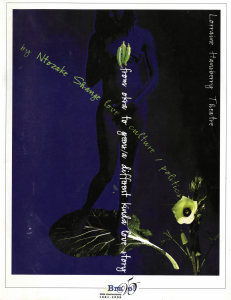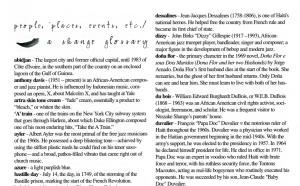To complete this task I used the Barnard Archives. I didn’t walk in knowing exactly what item I needed or what letter, unfinished play, or poster would solidify my understanding of Zake: I walked in a little restless and slightly resentful of the fact that there were so many possibilities.
… I realized later that the beauty of the archive is that the possibilities are evidence that there is so much to the making of a life.
At first I considered looking through the journals (Series 3), so I did. Then, I thought I should see the artwork collected by Shange (Series 8.2), so I did. And finally, I said to myself, “look at the photographs! You’re a person stimulated by visuals and perceptive to detail, so find something that catches your eye” — series 7. I rummaged through box number 7 and found a colored sketch of Josephine Baker which was striking, there were also postcards distinguished by pictures of Shange I had never seen before, and the suddenly, I found an 8 x 11.5 booklet of wonder. It was the Lorraine Hansberry Theatre (LHT) bulletin of From okra to greens/ a different kind of love story. In their 25th anniversary season the theatre choose to use this work to celebrate African-American History month.
This packet of paper was beautifully designed. The cover had a woman/ okra that made me consider my own femininity. The features, though under lit, were delicate. The minimal use of color and decision to focus on the layout/ geography of the text, the woman, and the okra was captivating. I am also curious about the three words that follow Shange’s name: love, culture / politics. Shange was present during the rehearsals and completion of this work, so I wonder if she made a special request to have that included.
In addition, the entire item was very meta. It recognized Shange’s work, but also it’s role in fulfilling that work: “The LHT is proud to be a West coast home theatre for Shange.” There was also “a Shange glossary” of words specific to the production that, to me, depicts a responsive and active awareness.
Initially, this task was challenging… to have a whole lot to look through and not to know where to start. However, in letting my gut guide me and my internal, emotional reaction aid my decision making, I became at ease. Funny enough, finding this item helped me solidify some of the ideas for my research project. The consistency of diasporic/ alter(native)-continental words featured in the glossary led me to question artists calling upon and relation to their places of origin, known and unknown.



